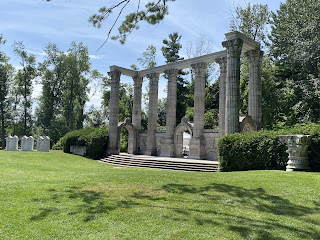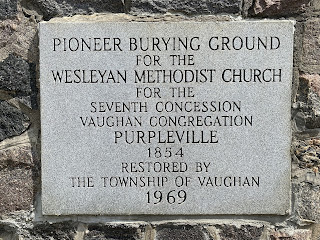This week started with me going to a new park in Toronto - Guild Park and Gardens. A couple of friends had suggested that I would enjoy it - and I did, very much.
This scenic and historic park is a sculptural sanctuary and has beautiful gardens. What is now known as the Guild Inn was built in 1914 as a white stucco, arts and crafts style mansion originally surrounded by over 400 acres of gardens and woodlands. In 1932, the socially conscious couple the Clarks bought the home and they founded ‘The Guild of all Arts’; a place for artists and artisans where their work was created and collected for the enjoyment of many. When major cities began their transition from classical stone and marble buildings to contemporary styles, Spencer Clark had the foresight to save the important features from over sixty buildings and create Canada’s first architectural museum with a Greek theatre as the centre piece. Remnants of over 60 buildings from Toronto and elsewhere in Ontario now exist in and around the Guild gardens.
Built in 1914 this was originally a private residence and then became known as the Guild Inn.
To commemorate the 50th anniversary of the Guild Inn, the Clarks built an open-air theatre from remnants of the Bank of Toronto building which was originally built in 1912. Eight marble columns, plus Corinthian capitals and arches were repurposed along with a concrete stage and steps to form an open-air theatre.
This is the Osterhout Log Cabin. The actual date of its construction is unknown however studies date it to sometime in the 1850s.
The belfry and bell from O’Sullivan’s Corner School (1873)
Mobius Curve - by Michael Clay
Art Deco limestone blocks from the Old Toronto Star Building (1929)
Bear - by E.B. Cox and Michael Clay
Copper bas-reliefs of Healey Willan and Ernest MacMillan and two entrance headers from the Toronto Conservatory of Music Building (1897)
Stone carvings from The Quebec Bank (1912)
The exterior entrance, stone carvings and columns from the Bank of Nova Scotia (1903).
Art nouveau sandstone carvings from the Canadian Bank of Commerce Building (1899)
This is just a small sampling of the many architectural relics located throughout the park. Additionally, there are also lovely gardens.
My hand is there to give you a perspective of just how large these leaves are.
I’m sure it’s not a good thing that bugs are eating these leaves, but I love the lacy way they look now!
Lastly the park also features walking paths and trails, some of which lead to the top of the bluffs overlooking Lake Ontario.
It took a lot of looking to find a path down to the bottom but I did finally find one, with a trail along the bottom that led to a little, secluded beach area.
The chestnuts are starting to get darker in colour…signaling a season change.
Saw this one (above) first and then a few blocks later the artist was definitely redefining their craft (below).
I’ve seen the red floor on this building but didn’t realize until I saw it from this angle that the floor is actually off-centre too.
Built in 1890, this home was is a rare example in its neighbourhood of an original semi-detached house.
One doesn’t often see a free-standing pedestal sink by the side of the road while walking.
Etobicoke Creek is 61 kms long and the western most of all the rivers and creeks in Toronto that flow into Lake Ontario. The creek ends at Marie Curtis Park and this part of the creek is surrounded by cliffs and shale banks. The Etobicoke Creek Trail runs from Lake Ontario north for approximately 6 kms. Because it was so hot I couldn’t walk the entire trail but I did a few kms starting at the lake.
The mouth of Etobicoke Creek looking out into Lake Ontario.
There are two beaches here at Marie Curtis Park, one on each side of Etobicoke Creek. The east one (above) is smaller, has lifeguards, and tends to be a bit more popular…but when it gets busy on a hot day, the west beach (below) will do just fine too!
A great blue heron…having a shower.
Not a usual spot to find a lost bike helmet.
I liked this artwork under the bridge. To be honest I didn’t really see anything on first look but then at just the right angle the images appear.
The ‘Elizabeth White House’ was built in 1896.
On the grounds of Ontario’s Parliament House - ‘to commemorate the struggle for responsible government in Upper Canada and the pioneers of a political system which unites in free association the nations of the British commonwealth’.
This shows you how long it’s been since this building was open to the public. We’re in the middle of a stretch of 40 degree days and this sign that says “Caution - Falling Ice and Snow” is still out in front of the building.
This house was built in 1872 and purchased by Sir John A. MacDonald, Canada’s first prime minister, in 1876. Later, in 1888 The Honourable Oliver Mowat, the premier of Ontario bought the house and lived here until 1902.
Built in 1892, this magnificent house was used during the Second World War as a headquarters for initial officer training.
This week ended with me taking a small road trip to a little town called Shelburne which is about an hour and a half north and west of Toronto. There’s not really much in Shelburne but the people I was meeting there were well worth the drive. One of my dearest and long-time friends, her husband and their two sons, my godsons. It’s been nearly two years now since I’ve seen them…and in another week both boys are off to university. One is heading to Québec and the other to British Columbia, so our visit tonight was super special!
Since I had the whole day I took my time driving up to Shelburne and my first quest was to see if I could find “Purpleville”. I did - or what’s left of it now anyway. Guess I won’t be moving here.
The new subdivision which is being built in this area is going to have a great street name!
Further north and look what I found - the Humber River! Here it is about 45 kms north of where I was walking on the trail in my other post.
Everyone has their parking spot!
Officially opened in 1915 this was the ‘new’ post office in Shelburne - the post office had originally been located inside the Town Hall.
The Town Hall in Shelburne, built in 1882, included an opera hall and lock-up, just as it does today.































































































